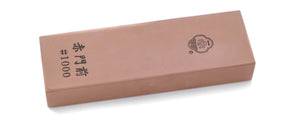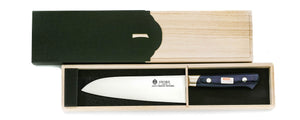Tenjinbashi O-Sakana Shokudō
A restaurant that values its knives can make delicious things
As the number of restaurants that are particular about their ingredients increases, chefs too are becoming more selective about what kitchen knives they use to bring the most out of these ingredients. We believe that restaurants and chefs that carefully choose their knives and maintain them can make delicious food.
Our "Connecting with Taste: Chef Interviews" series is dedicated to introducing restaurants that create amazing cuisine through the charm of their chefs, greater than the sum of their parts which gourmet review websites cannot give justice to.
These places value technology, philosophy, tradition, and look at food from the perspective of not only themselves, but the kitchen knives they are wielding.
Our 13th volume takes us to Tenjinbashi O-Sakana Shokudō (天神橋おさかな食堂) in Osaka's Tenmabashi area to speak with chef-owner Hayashi Keisuke (林 圭佑). Hayashi has a dream to make amazing teishoku cuisine, with aji fry or fried horse mackerel as his star cuisine.
Read along, step into the inner side of these chefs, and enjoy their stories.
Table of Contents
- From Supply Chain Experience to Signature Dish
- Profound Simplicity in the Basics
- The Ties between French and Teishoku Cuisine
- His First Kitchen Knife at 20
- Life's Detours Help Shape The Present
- A Dream: Japan's Best Fried Horse Mackerel
- Restaurant Information
- Watch Our Video Documentary
- Chef Hayashi's Recommended Kitchen Knives
From Supply Chain Experience to Signature Dish
Hayashi is originally from Osaka, where his restaurant is now. After graduating university, he worked at several restaurants, supermarkets, and wholesale markets, engaging with the entire distribution chain from beginning to end. Opening Tenjinbashi O-Sakana Shokudō (Tenjinbashi Fish Restaurant) in August 2024 with the combination of all his experiences, Hayashi's signature dish is fried horse mackerel.
Hayashi chose to work with horse mackerel because of his stronger relationship to it than other fish. When he worked at a fishery company in the central wholesale market, he was in the department that sampled fish to be exported to Africa. He was in the process of examining every detail of these fish, and told us he was probably handling more horse mackerel than anyone else in Japan at the time.
So, horse mackerel comes with a strong sense of familiarity to Hayashi.
Profound Simplicity in the Basics
Hayashi experimented with all different kinds of horse mackerel, including ones said to be more famous. But, as this restaurant is a teishoku (set meal) restaurant, balancing taste with price is crucial. From all the fish he sees, he only selects the finest horse mackerel. These are of such quality that they could even be served as sashimi.
Choosing a fish isn’t simply about its size. If the flesh is too thick, the balance with the coating is off, and the fluffy texture will be lost when eating it. Ideally, Hayashi tries to make fried horse mackerel that is 1:1 ratio of coating to fish. Frying also needs to be done in such a way that the breadcrumbs remain crispy, and the flesh of the fish is stays so soft that it almost crumbles when eating. To be able to create this experience, Hayashi has to be paticular about the weight and size of the fish.
As a food, fried horse mackerel is quite simple. All the batter needs is flour, eggs, breadcrumbs, salt, and pepper. Hayashi believes the basic steps of making this are the same at any restaurant.
But, he's particular not only about the fish itself. He also really cares about the coarse breadcrumbs. On top of that, he stays true to the basics, believing it’s important not to overcomplicate things.
Frying may seem easy enough to do at home, but it’s a surprisingly deep technique. To serve a taste that impresses both the very first customer and the ten-thousandth customer, every single batch counts. Perfecting it is a challenge, and that’s what makes it so enjoyable to him.
The Ties between French and Teishoku Cuisine
Hayashi mentions that, infact, most of the restuarants where he trained were French restaurants or high-priced ones that people tended to visit for anniversaries or special occasions.
What those places valued most was giving customers the experience of enjoying freshly prepared dishes right before their eyes in an open kitchen.
Filleting horse mackerel right in front of the customers is exactly in line with that. The aroma of freshly cooked rice rises from the steaming clay pot, accompanied by piping-hot miso soup and fresh horse mackerel, fried to the perfect level of crispness right before their eyes.
Ultimately, Hayashi says he is happy if he can just add a little joy to the daily lives of many people with the fried horse mackerel that he has made.
His First Kitchen Knife at 20
Hayashi remembers that his senior at a restaurant he used to work at used Sakai Ichimonji Mitsuhide knives. And from there, he bought his first knife from us at twenty years old. A long-term relationship was born.
His deba and yanagiba have seen a lot of usage over the years. He said he's never had them professionally sharpened through us, but he's considering giving it a try.
Life's Detours Help Shape The Present
Now that Hayashi has turned 40, he realizes that cooking is all he really has. Losing his father in 2023, he more strongly realised that we can't take anything with us when our time is up. This rekindled a fire in him, encouraging the thought: "I want to leave something in the world."
The last location where Hayashi trained was a French restuarant, but he decided to put aside everything he had done up until then, such as his experience and meticulousness, and take on a new challenge for a wider audience by opening a teishoku restaurant.
In the end, everything seems to have come together for Hayashi. From using horse mackerel, a fish he has always been familiar with, to having colleagues from the seafood company he used to work for involved in the deliveries, it feels as though all the experiences he’s had up to now are connected to what he’s doing today.
He started out on his own later than most people and took many detours along the way, but once he made up his mind that “this is what I’m going to do,” more and more people began to support him.
Now, he can finally say that he’s glad he chose this path, and he’s come to accept and take pride in his decision.
A Dream: Japan's Best Fried Horse Mackerel
Hayashi says there are various kinds of regular customers. Many are local elderly people and young people living alone. When they say “thank you,” it makes him feels like he’s found his place in life.
Right now, Hayashi’s first priority is to stabilize Tenjinbashi O-sakana Shokudō, but there are many things he wants to challenge himself with in the future.
He hopes to serve simmered dishes, further promote the appeal of fish, and above all, he dreams that someday, with his signature fried horse mackerel, the restaurant can become the best in Japan.
Restaurant Information
Text
Tenjinbashi O-sakana Shokudō (Tenjinbashi Fish Restaurant)
https://instagram.com/tenjinbashi_ajifry
2-Kita 1-14 Tenmabashi Higashimaru 1F, Tenjinbashi, Kita Ward, Osaka
06-6647-1238
Trading Hours
Lunch: 11:00~14:00 (11AM-2PM)
Dinner: 17:00~21:00 (5PM~9PM)
Closed the first Wednesday of each month, and all Sundays
Watch Our Video Documentary
Our Japanese YouTube team also filmed a mini video documentary on Chef Hayashi and Tenjinbashi O-Sakana Shokudō . Enjoy the video below.
Please note it only officially has Japanese audio and subtitles, but automatic translations are available. Nuance and meaning may be lost though, so please refer back to the original Japanese as fact over any translations.
Chef Hayashi's Recommended Kitchen Knives
A customer of ours for over twenty years, Hayashi is experienced with what we offer, especially in the world of preparing aji fry. See some of his favorites of ours below.
Sakai Ichimonji Mitsuhide White Steel #2 Tan Kasumi Deba
Our White Steel #2 Deba is one of the most popular traditional knives we sell thanks to its high performance and price point, but we also created a second series of this knife.
Our Tan Kasumi series, forged at a lower temperature, has increased durability and edge retention over our regular White Steel #2 unit.
Either are good, but this one will last longer overall. A great knife for those looking for the best price performance we can offer.
Sakai Ichimonji Mitsuhide White Steel #2 Tan Kasumi Yanagiba
Our Tan Kasumi series comes in more than just deba knives, others such as yanagiba (and even usuba) exist too.
With a large variety of ranges available also, this line firmly sits in the quality tier of performing well, while lasting a long time also.
As these are carbon steel they do require more maintenance than stainless steel counterparts, yet this maintenance is very easy to do, and if done correctly allows this knife to serve you for many years.
Using this yanagiba in tandem with the deba above makes for a perfect start to any Japanese cuisine fan or professional chef!































